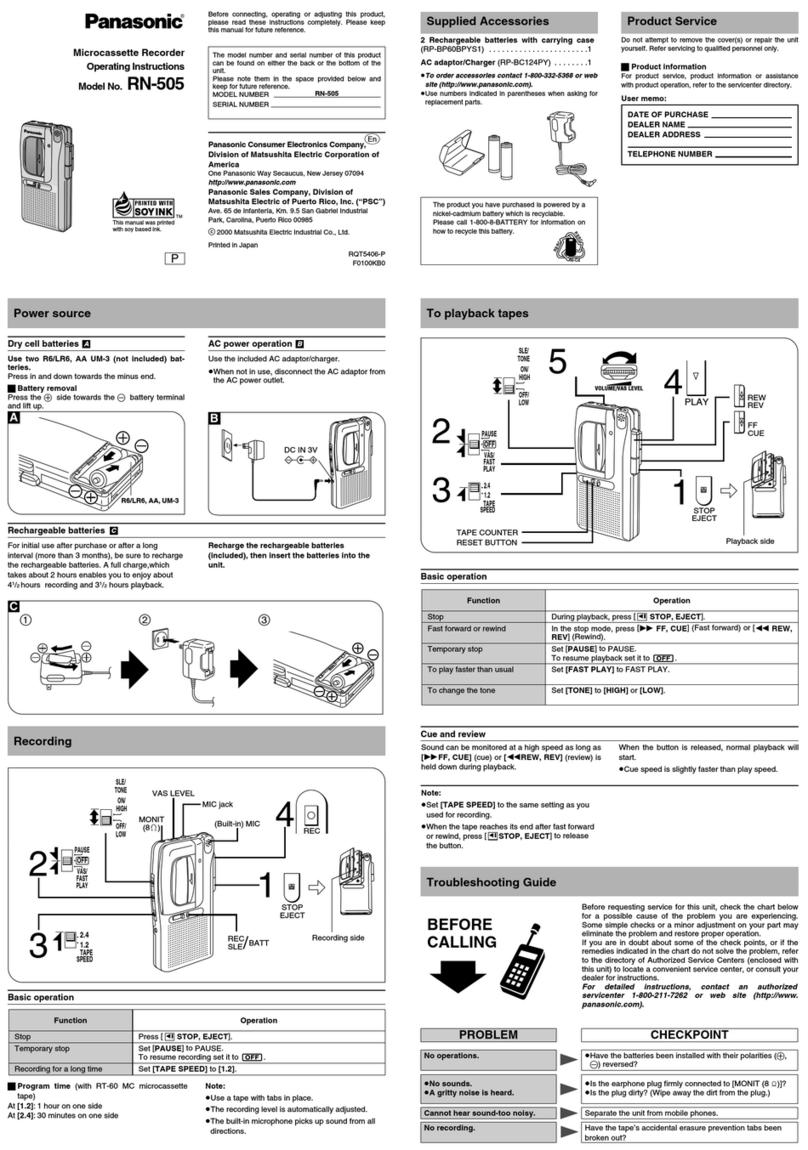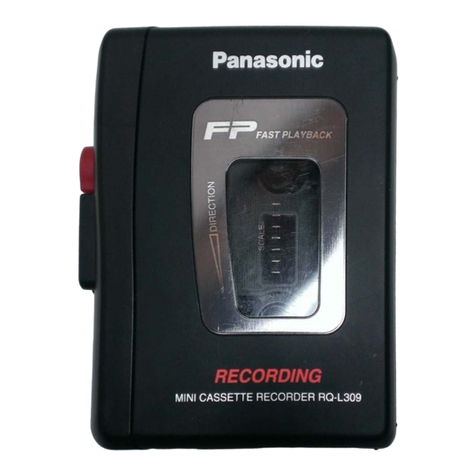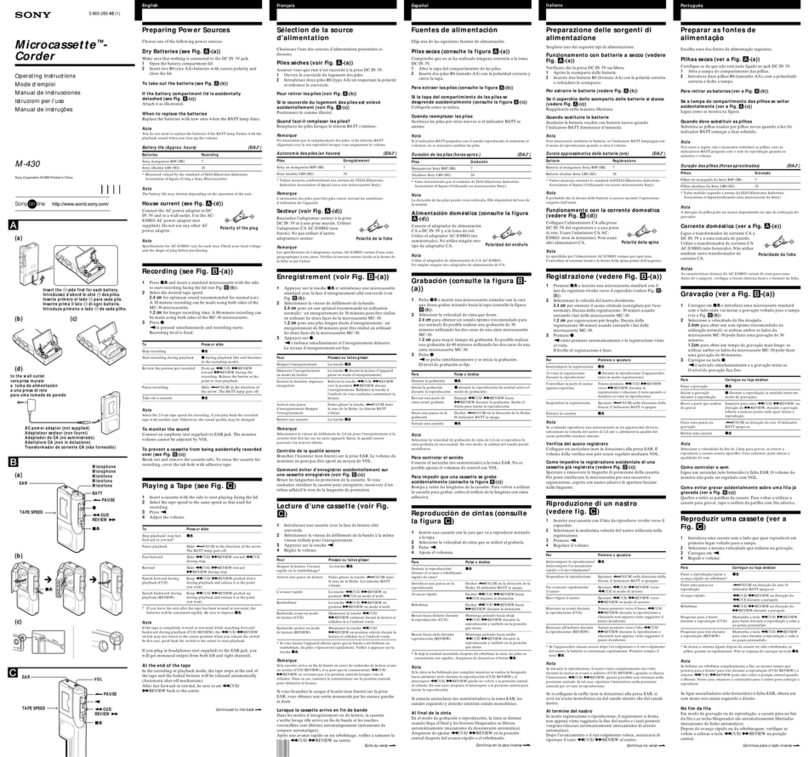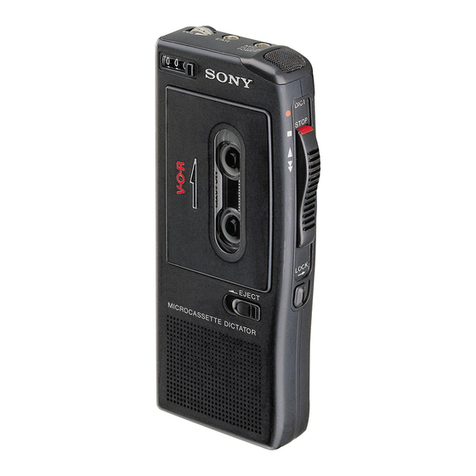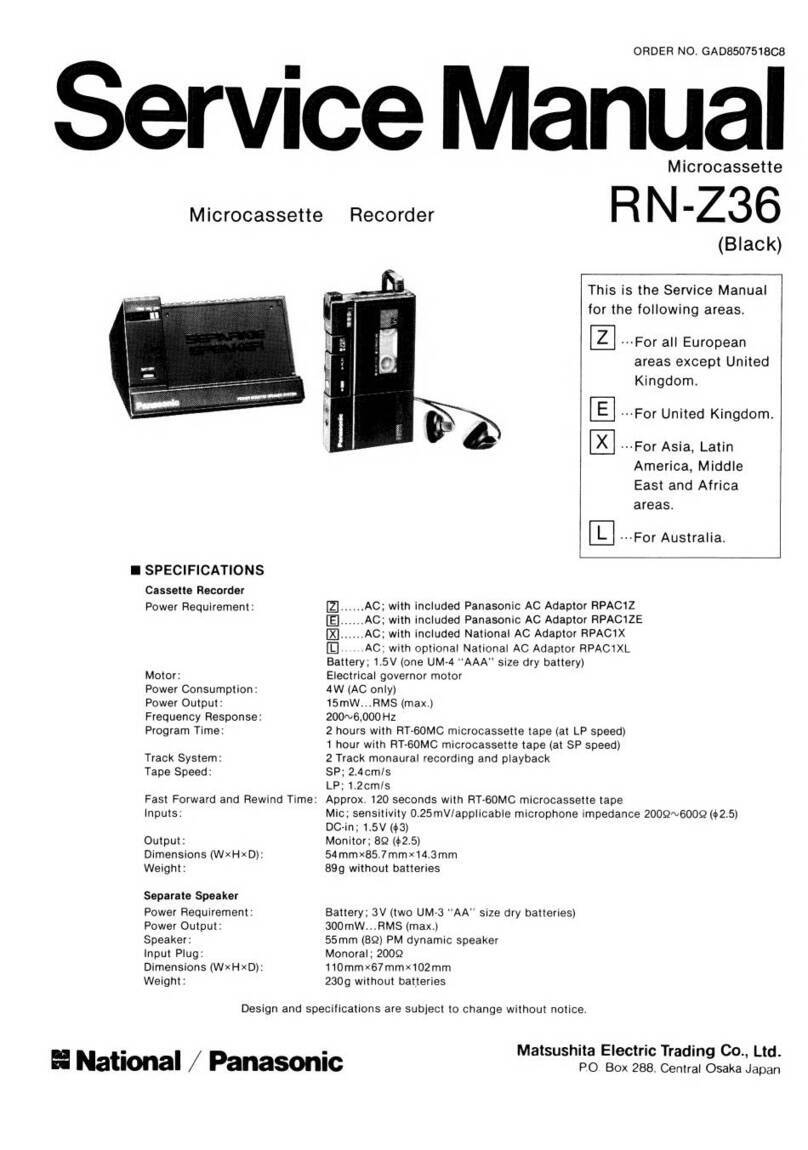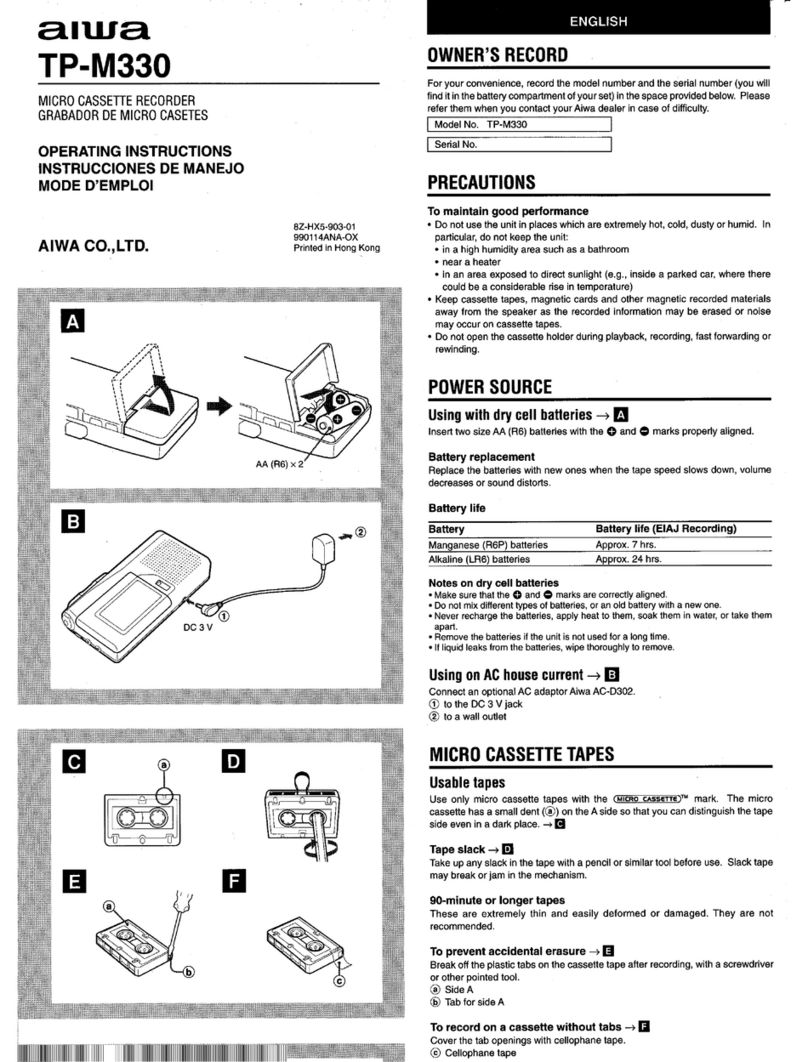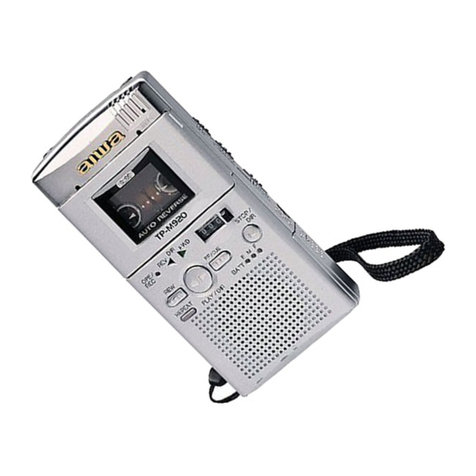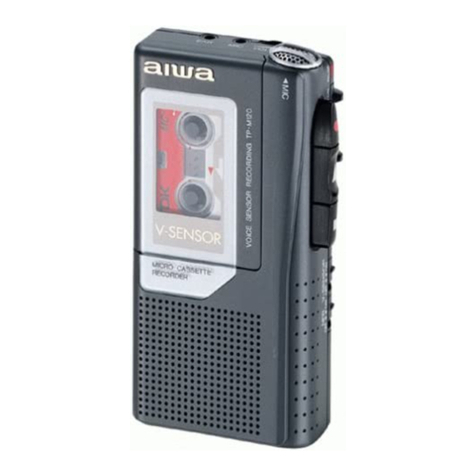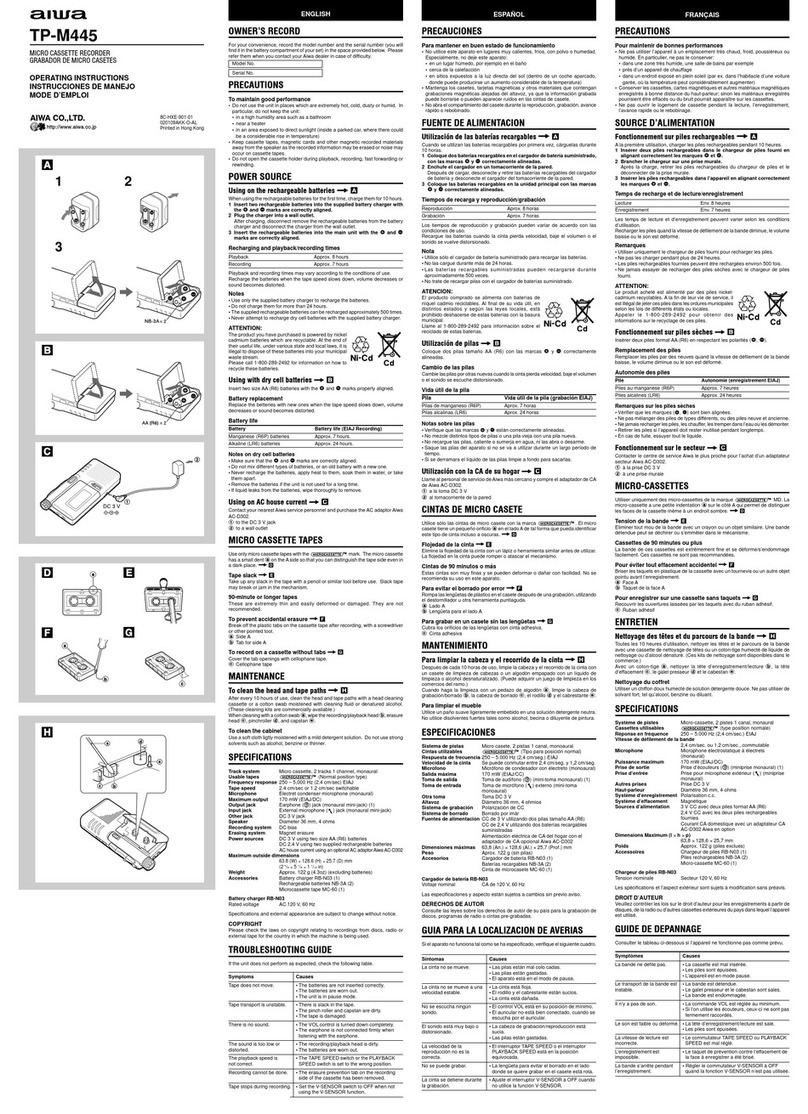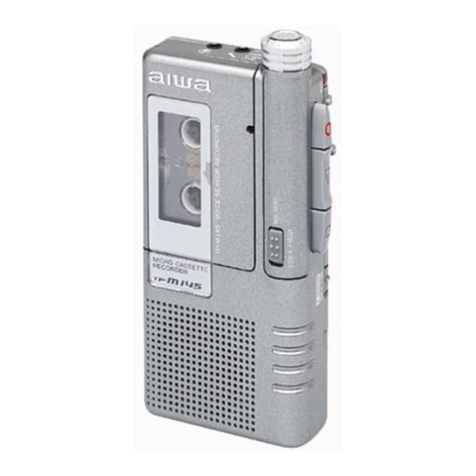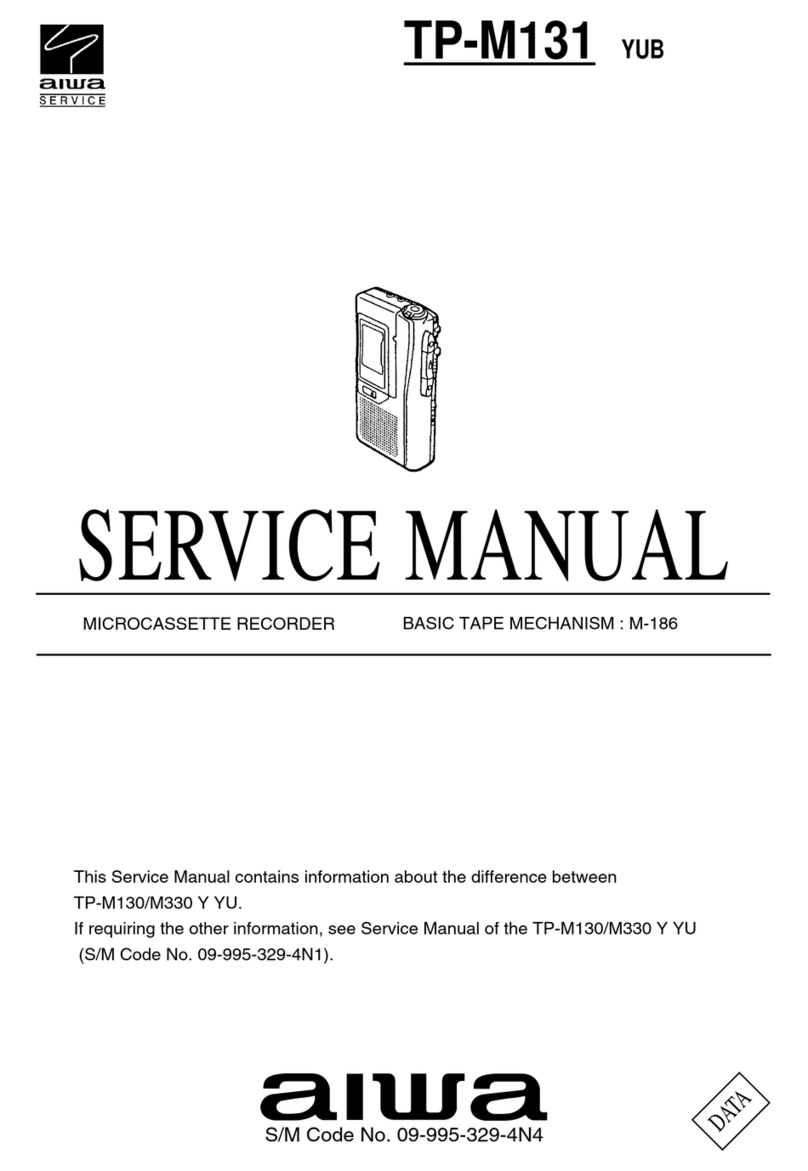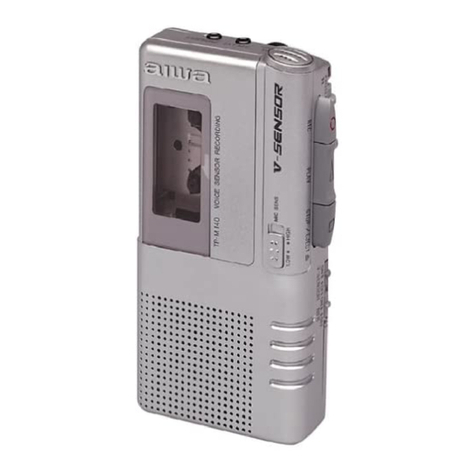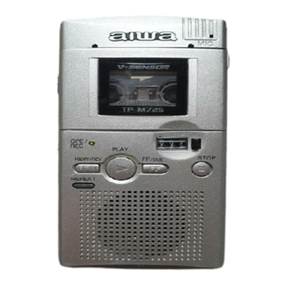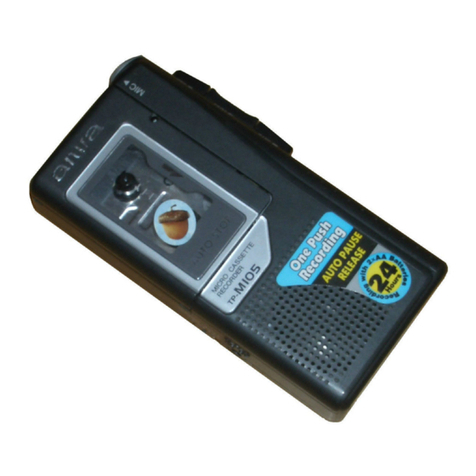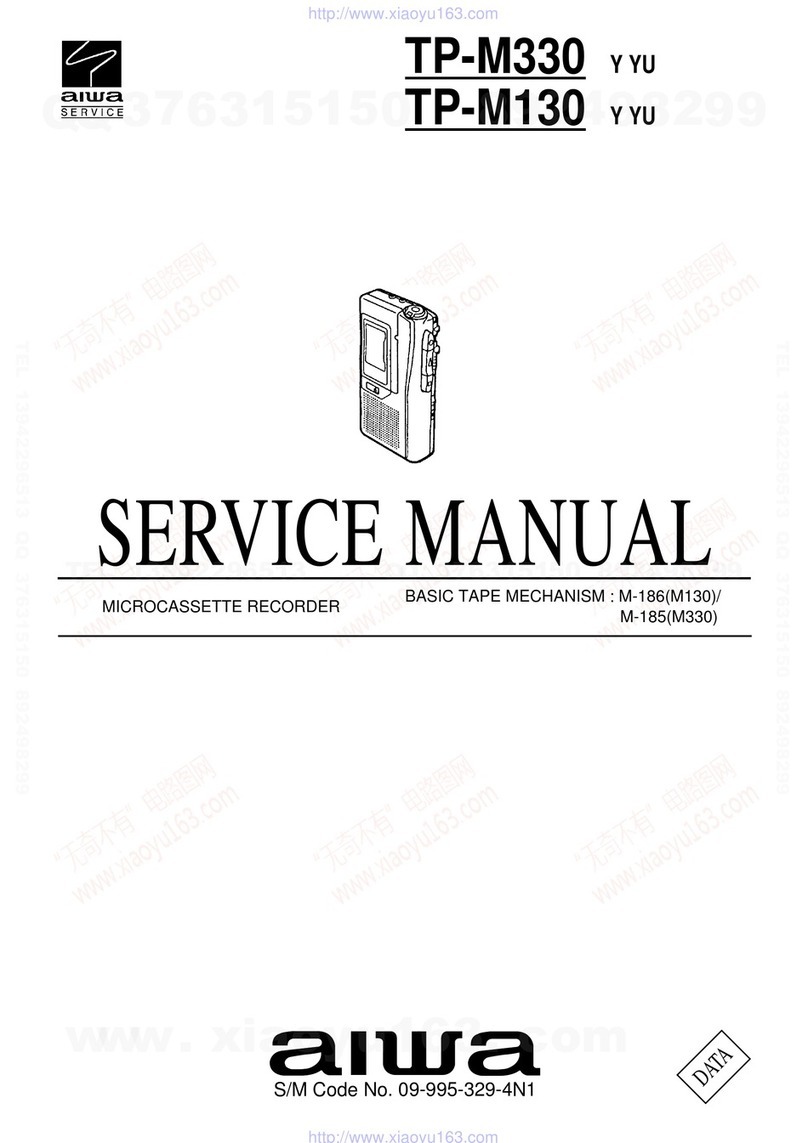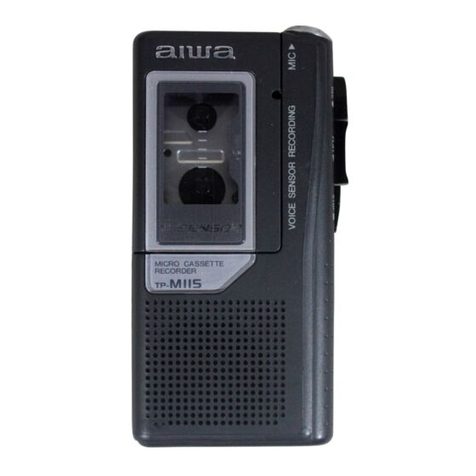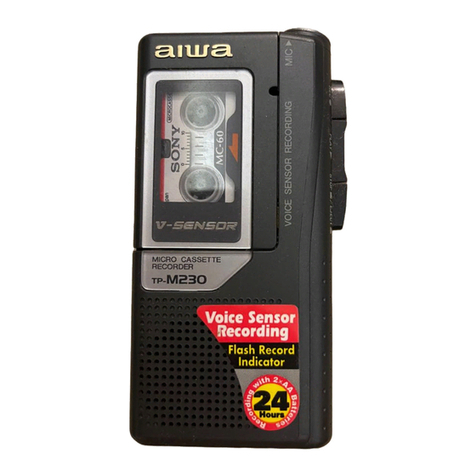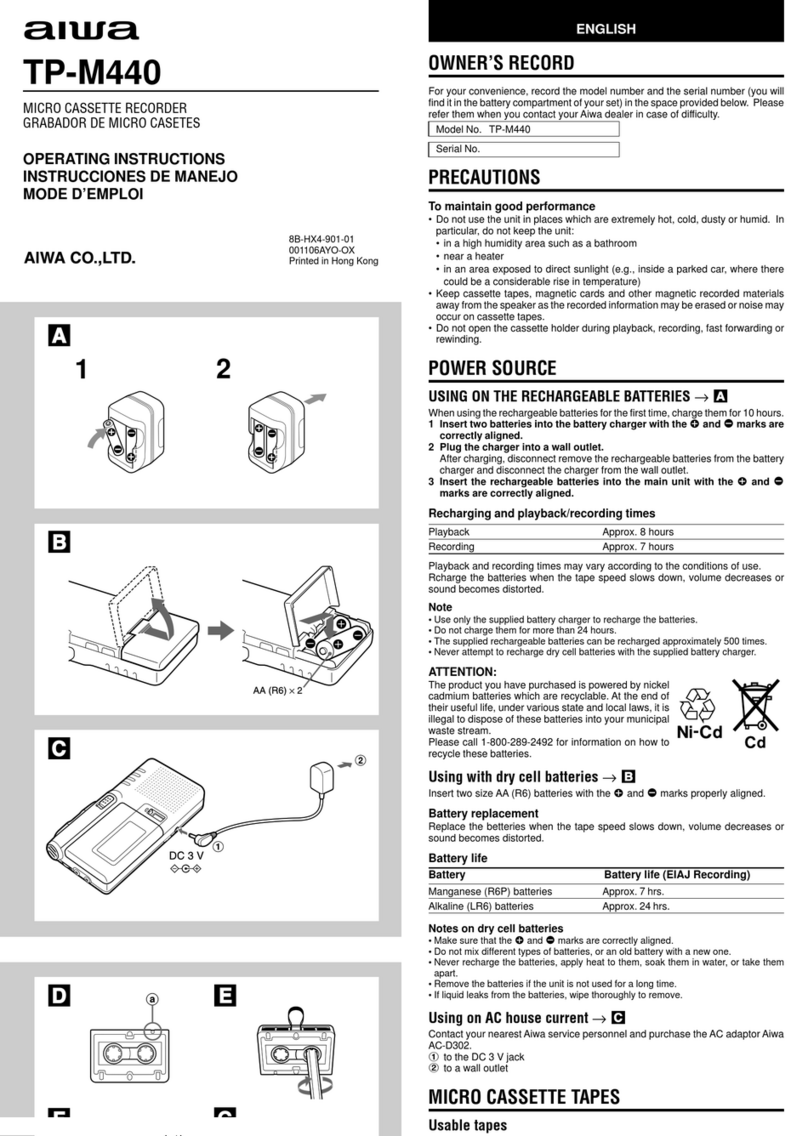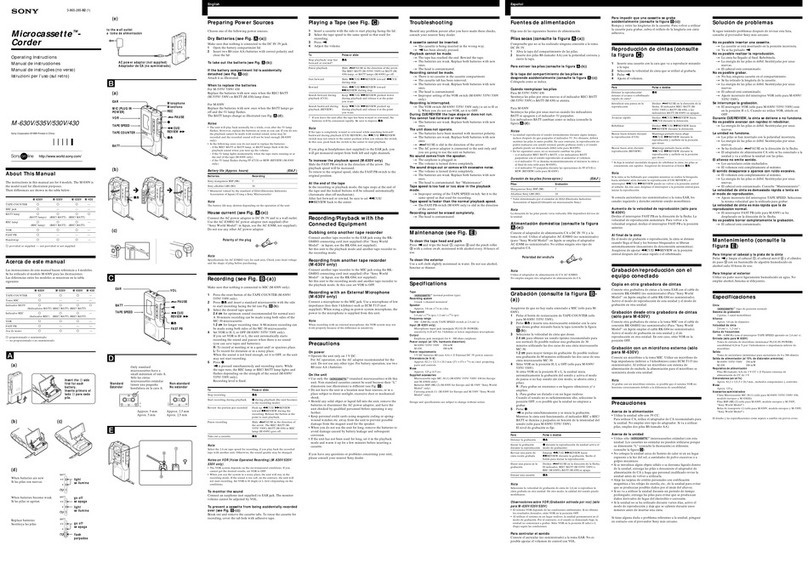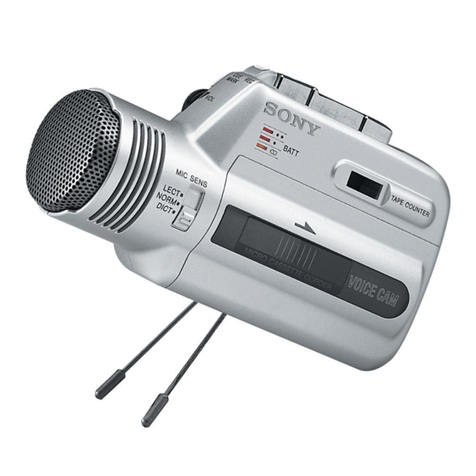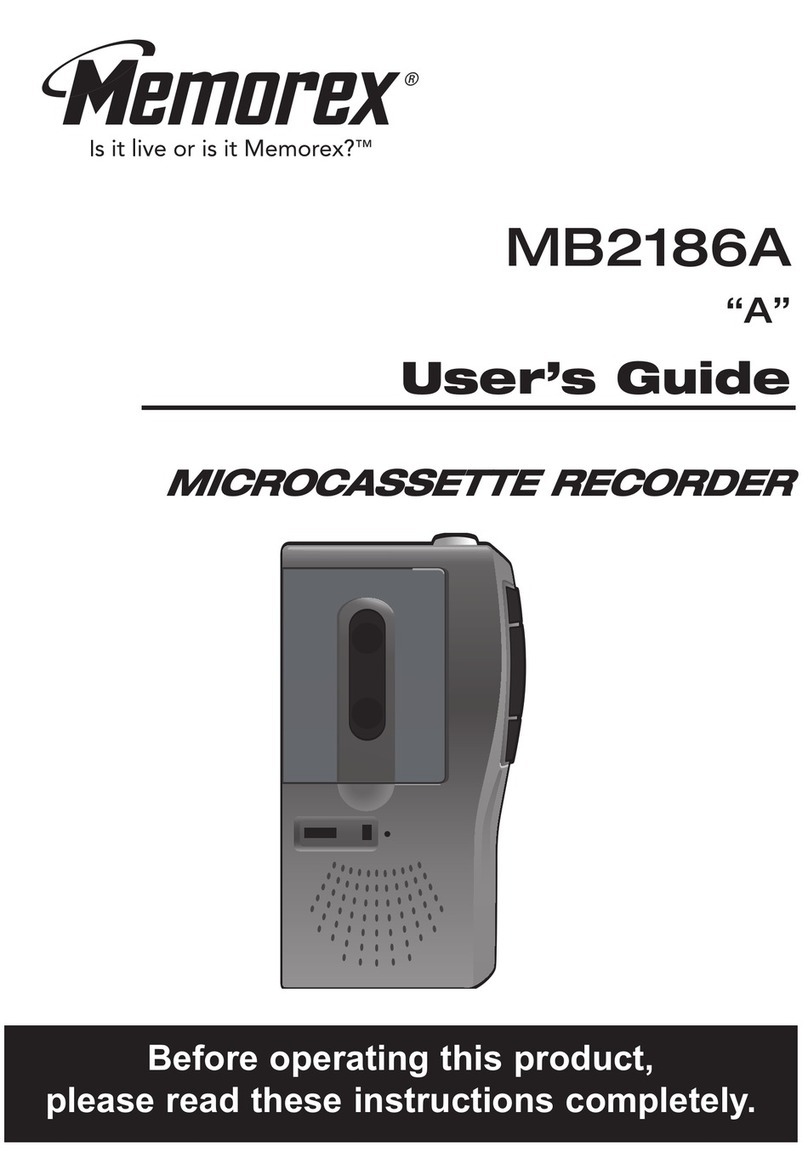COLOCACION DE UN CASETE +❑INSERTING ACASSETTE+ ❑INSERTION D’UNE CASSETTE+ ❑
Appuyer sur la touche ■/4 STOP/EJECT pour ouvrir Ie Iogement de cassette et
inserer une cassette, Ie c&e enregistrement/lecture (@) dirig6 vers Ie Iogement
de cassette.
Press the ■/= STOP/EJECT button to open the cassette holder and insert a
cassette with the recording/playback side (@) facing the cassette holder. Oprima el bot6n de parada/expulsi6n (■/= STOP/EJECT) para abrir la tapa del
comparlimiento del casete ycoloque un casete con el Iado agrabar/reproducer
(@) hacia la tapa del compartimiento del casete,
RECORDING FROM THE BUILT-IN
MICROPHONE +❑GRABACION UTILIZANDO EL MICROFONO
INCORPORADO DEL APARATO +❑ENREGISTREMENT AVEC LE MICROPHONE
INTEGRE +❑
1Insert acassette.
2Set the TAPE SPEED switch.
2.4: Normal recording
1.2: Double time recording
E.g.) A60-minute recordingcan be made usingboth sides of the MC-30
microcassette.
3Press the ●REC button to start recording.
The ~PLAY buttonis depressed simultaneouslyand the recording
indicator(@) lightsin red.
1Coloque un casete.
2Mueva el interruptor de velocidad de la cinta (TAPE SPEED).
2.4: Grabaci6n normal
1.2: Grabaci6n del doble de tiempo
Por ejemplo:)
Una grabacion de 60 minutes puede hacerse utilizando Ios dos Iados de
un micro casete MC-30,
3Oprima el boton de grabacion (0 REC) para empezar agrabar
El botch de reproduction (< PLAY) baja simultdneamente y se enciende el
indicadorde grabaci6n (@) en rojo.
Apunte el microfonoala fuente de sonido.
1Inserer une cassette.
2Regler Ie commutateur TAPE SPEED.
2.4: Enregistrement normal
1.2: Enregistrement temps doubk$
Asavoir: Un enregistrement de 60 minutes est possible en utilisant Ies deux
cdes de la micro-cassette MC-30.
3Appuyer sur la touche ●REC pour demarrer I’enregistrement.
La touche <PLAY est simultanement pressr$eet Ietdmoin d’enregistrement
(@) s’allume en rouge.
Orienter Ie microphone int6gr6 vers la source sonore.
Orient the built-in microphone to the sound source.
Basic operation
To stop recording Press the ■/= STOP/EJECT button.
To pause recording Set the PAUSE switch to ON.
To resume recording, set the switch to OFF.
Operations de base
Pour arri%er I’enregistrement Appuyer sur la touche ■/4 STOP/EJECT.
Pour faire une pause Regler Ie commutateur PAUSE AON.
d’enregistrement .Le regler aOFF pour reprendre
I’enregistrement.
Funcionamiento basico
Para parar la grabacion Presione el boton de paradaJexpulsi6n
(9/4 STOP/EJECT)
Para hater una pausa en Presione e! conmutador de pausa (PAUSE) hacia
la grabacion el Iado ON. Para seguir grabacion, mueva el
interruptor hacia el OFF.
When the end of the tape is reached
Press the ■/4 STOP/EJECT button. Ala fin de la bande
Appuyer sur la touche ■/= STOP/EJECT.
Tape counter (~)
The readout of the tape counter changes during playback, recording, fast-
forwarding or rewinding of the tape.
To set the counter to 000, press the COUNTER button to the right of the tape
counter.
Cuando la cinta Ilega asu final
Oprima el boton de parada/expulsi6n (9/= STOP/EJECT). Compteur (@)
L’indication du compteur change pendant la lecture, I’enregistrement, I’avance
rapide ou Ie rebobinage de la bande.
Pour remettre Ie compteur a000, appuyer sur la touche COUNTER adroite du
compteur.
Contador de cinta (~)
La Iectura en el contador de cinta cambia durante la reproduction, grabacion,
avarice rapido orebobinado de la cinta.
Para volver et contador al 000, presione el bot6n de reposici6n del contador
(COUNTER) hacia la derecha del contador de cinta.
To monitor the sound that you are recording
Use the earphone referring to “Listening with the earphone” below. You cannot
monitor the sound currently being recorded through the speaker.
Note
The standard speed of the micro cassette recorder is 2.4 cm/sec. If you record a
tape with the TAPE SPEED switch set to 1.2 and play it back on another micro
cassette recorder,playback sound may not be correct,
Pour contrtiler Ie son pendant I’enregistrement
Utiliser Ies ecouteurs en consultant “Ecoute avec des dcouteurs” ci-dessous. Le
haut-parleur ne permet pas de contrbler Ie son en tours d’enregistrement.
Para controlar el sonido amedida que se va grabando
Utilice et auricular consultando el punto “Escuchando por el auricular” mas abajo.
Nose puede controlar el sonido amedida que se va grabando utilizando el altavoz.
Nota
La velocidad normal del grabador de micro casete es de 2,4 crn/seg. Sise graba una
cinta con e! interruptor de velocidad de la cinta (TAPESPEED) en la position 1.2 y
se reproduce en otro grabador de micro casete distinto, el sonido puede no
reproducirse correctamente.
Remarque
La vitesse standard de defilement de la bande est de 2,4 cm/sec. pour
I’enregistrement. Si une cassette enregistree avec Iecommutateur TAPE SPEED
regle a1.2 est Iuesur un autre enregistreur de micro-cassettes, Ie son pourra ne pas
~tre correct.
To record only above apreset sound level+ ❑
Recording will start when the unit detects sound above acertain preset level. If
the unit does not detect the sound for about 4seconds, recording will pause. This
prevents tape waste and empty recording.
1Set the V-SENSOR* switch to ON.
2Adjust the sensor level.
Turn the AVOL (V-SENS LEVEL) control in the direction of A(@) to lower
the sensor level. General background noise will not be recorded, and only
relatively loud sounds will be recorded,
Turn the dVOL (V-SENS LEVEL) control in the opposite direction of ~(@)
to increase the sensor level. Even relatively quiet sounds will be recorded,
3Press the ●REC button to start recording.
*Voice Sensor Recording
Pour enregistrer seulement au-dessus d’un niveau sonore
prer6g16 +Q
1[1!+11 lima ‘1 Para grabar solo Ios sonidos que estan por encima de un
nivel predeterminado +Q
La grabaci6n empezar~ cuando el aparato detecte un sonido por encima de un
nivel predeterminado. Si el aparato no puede detectar ningun sonido durante 4
segundos, la grabacion entrara en pausa. Esto es para evitar un desperdicio
inutil de la cinta yla grabaci6n en blanco.
1Mueva el interruptor V-SENSOR* ala position ON.
2Ajuste el nivel del sensor.
Gire el control de volumen (AVOL) del nivel del sensor de voz (V-SENS
LEVEL) en el sentido del A(@) para bajar el nivel del sensor. No se grabaran
Ios ruidos de fondo en general ysr510se grabaran Ios sonidos relativamente
fuertes.
Gire el control de volumen (AVOL) del nivel del sensor de voz (V-SENS
LEVEL) en el sentido opuesto hacia A(@) para subir el nivel del sensor.
Esto hara que se graben incluso Ios sonidos relativamente silenciosos.
3Oprima el boton ●REC para empezar agrabar.
*Grabaci6n detecci6n de voz
L’enregistrement demarrera quand I’appareil detectera un son au-dessus du niveau
preregle. Si I’appareil ne detecte aucun son pendant environ 4secondes, il passera
en pause d’enregistrement. Cela c%ite I’usage inutile de la bande et
I’enregistrement vierge.
1Regler Ie commutateur V-SENSOR* aON.
2Ajuster Ie niveau sonore.
Tourner la commande AVOL (V-SENS LEVEL) clans Iesens de A(@) pour
baisser Ie niveau de detection. Le bruit de fond ne sera pas enregistr6, seuls
Ies sons relativement forts Ie seront.
Tourner la commande -VOL (V-SENS LEVEL) clans Ie sens contraire de
A(@) pour augmenter Ie niveau de detection. M~me Ies sons relativement
faibles seront enregistres.
3Appuyer sur la touche .REC pour d’emarrer I’enregistrement.
*Enregistrement avec detecteur vocal
3●REC
1V-SENSOR
Sensor level adjustment
The ideal sensor level varies according to the loudness of the source sound.
Experiment with the sensor level inadvance to determine the optimum level before
you start an important recording, Normally, align the white mark (@) of the AVOL
(V-SENS LEVEL) control with the part (@) first, then adjust it according to
surrounding conditions.
Note
When the recording resumes after sound detection, the very first sounds may not be
recorded.
Ajustement du niveau de detection
Le niveau sonore id6al varie selon l’intensit6 de la source sonore. Faire des essais
pr6alables de niveau de detection pour determiner Ie niveau optimum avant de
commencer un enregistrement important. Normalement, alignez d’abord la marque
blanche (@) de la commande AVOL (V-SENS LEVEL) sur la partie (@), puis
ajustez la commande en fonction des conditions environnantes.
Remarque
Ala reprise de I’enregistrement apres la detection de sons, Iestout premiers sons
peuvent ne pas 6tre enregistres.
Ajuste del nivel del sensor
El nivel del sensor optimo depende del volumen de la fuente de sonido. Haga
previamente varias pruebas con el nivel del sensor para determiner el nivel ideal,
antes de empezar una grabacion importance. Normalmente alinee primero la
marca blanca (@) del control 4VOL (V-SENS LEVEL) con la parte (@) yajuste
de acuerdo con Ias condiciones ambientales,
Nota
Cuando se empieza agrabar,despu& de detectar el sonido, Ios primeros segundos
del sonido nose grabaran.
To record the human voice more clearly+ ❑
When the voice you want to record is soft, and the surroundings are noisy, set the
NFR switch to ON and start recording. The voice will be recorded more clearly.
How NFR (Noise Filtration Recording) works
NFR emphasizes the frequency range of the human voice more than the high
and low frequencies that usually comprise noise.
●NFR does not reduce noise already recorded on the tape.
Pour enregistrer plus clairement la voix humaine +❑
Quand la voix aenregistrer est deuce et Ies environs bruyants, regler Ie
commutateur NFR aON avant de demarrer I’enregistrement. L’enregistrement
de la voix sera plus net.
Para grabar nitidamente la voz humana +K
Cuando la voz que se desea grabar es suave yel Iugardonde se hate la grabacion
es muy ruidoso, mueva el interruptor NFR ala position ON yempiece agrabar.
La voz se grabara mas nitidamente.
To record from another unit+ ❑
Connect the other unit to the EXT MIC jack of this unit, using the appropriate
connecting cords.
@To connect to stereo source equipment
@To connect to monaural source equipment
Fonctionnement du NFR (enregistrement avec filtrage du bruit)
Le NFR accentue la gamme de frequencies de la voix humaine plus que Ies hautes
et basses frdquences qui composent ordinairement Ie bruit.
●Le NFR ne reduit pas Ie bruit deja enregistre sur la bande.
oAttenuation Cable
a(Monaural mini-plug -Stereo mini-plug)
Cable de atenuaci6n
(mini-enchufe monoaural ++mini-enchufe estereo)
Cable d’attenuation
(miniprise monaural++ miniprise sk%do)
Funcionamiento de! NFR (Grabacion con filtro de ruido)
El NFR Ie da m~s dnfasis ala gama de frecuencias de la voz humana para que
se graben por encima de Ias frecuencias altas ybajas que son Ias que
normalmente forman parte de Ios ruidos del Iugar.
●El NFR no sirve para reducir el ruido que ya ha sido grabado en la cinta.
Note
●The connecting cords may vary according to the type of source equipment. Before
connecting aunit, read the operating instructions of the connected unit.
●Ifthe volume setting of the source equipment is too high, the recorded sound may
be noisy or distorted. Be sureto set the volume of the source equipment to a
moderate level.
Pour enregistrer depuis un autre appareil +❑
Raccorder I’autre appareil ala prise EXT MIC de cet appareil, avec Ies cordons
de raccordement adequats.
@Pour raccorder un appareil de source stereo
@Pour raccorder un appareil de source monaural . .
Para grabar de otro aparato +❑
Conecte el otro aparato en la toma de microfono externo (EXT MIC) de este
aparato, utilizando Ios cables de conexion correctos.
@Para conectar un equipo con una fuente en estereo
@Para conectar un equipo con una fuente monoaural
Nota ‘
●Loscables de conexion pueden ser distintos de acuerdo al tipo de equipo utilizado
como fuente de sonido. Antes de conectar el aparato, lea Iasinstrucciones de
funcionamiento del aparato conectado.
●Si el ajuste del volumen del equipo que sirve de fuente est~ muy alto, el sonido
grabado puede contener muchos ruidos oquedar distorsionado.Asegurese de
poner etvolumen del equipo con la fuente de sonido a un nivel moderado.
Remarques
●Lescordons de raccordement peuvent varier selon Ie type de I’appareil de source.
Avant de raccorder un appareil, Iireson mode d’emploi.
●Si Iereglage de volume de I’appareil de source est trop eleve, Ie son enregistre
peut &re parasite ou deforme. Bien regler Ievolume de I’appareil de source a un
niveau modere.
PLAYBACK +❑
1Insert acassette.
2Set the TAPE SPEED switch to the same position it was in during the
recording.
3Press the +PLAY button to start playback.
4Adjust the volume. LECTURE +❑
Attenuation Cable
(Monaural mini-plug eMonaural mini-plug) Basic o~eration
Cable de atenuaci6n
(mini-enchufe monoaural ++mini-enchufe monoaural)
C5ble d’atk%uation
(miniprise monaural++ miniprise monaural)
1Inserer une cassette.
2Regler Ie commutateur TAPE SPEED ala m~me position que pendant
I’enregistrement.
3Appuyer sur la touche +PLAY pour demarrer la lecture.
4Ajuster Ie volume.
To stop playback Press the ■/A STOP/EJECT button.
To pause playback Set the PAUSE switch to ON.
To resume playback, set the switch to OFF. REPRODUCTION +❑
When the end of the tape is reached
Press the ■/& STOP/EJECT button.
1Coloque un casete.
2Mueva el interruptor de velocidad de la cinta (TAPE SPEED) ala misma
position en la que estaba durante la,grabacion.
3Presione el boton de reproducci6n (+PLAY).
4Ajuste @nivel del volumen.
Operations de base
Pour arr6ter la lecture Appuyer sur la touche ■/= STOP/EJECT.
Pour faire une pause de lecture Regler Ie commutateur PAUSE &ON.
Le r%glerAOFF pour reprendre la lecture.
To find the section you want to listen to
To fast forwardhewind
To fast forward: Slide the +FF/CUE/- REW/REV switch to 4+ FF/CUE
during stop mode.
Torewind: Slide the 44 FF/CUE/ -REW/REV switch to WREW/REV during
Funcionamiento basico En fin de bande
Appuyer sur la touche WA STOP/EJECT.
Para parar la reproduction Presione el bot6n de parada/expulsi6n
(¤/~ STOP/EJECT).
Para hater una pausa en la Presione el conmutador de pausa (PAUSE)
reproduction hacia el Iado ON.
Para seguir reproduction, mueva et interruptor
hacia el OFF.
stop mode.
Press the ■/4 STOP/EJECT button at the desired point. Pour trouver la section souhaitee
❑To search while monitoring high-speed sound
Keep the 4+ FF/CUE/- REW/REV switch slid to 4+ FF/CUE or -REW/
REV during playback. When you reach the desired point, release the switch to
resume playback,
Pour I’avance rapide/rebobinage
Pour I’avance rapide: Glisser Ie commutateur 44 FF/CUE/- REW/REV sur
+FF/CUE en mode d’arr~t.
Pour Ie rebobinage: Glisser Ie commutateur +FF/CUE/~ REW/REV sur
-REW/REV en mode d’arrat.
Appuyer sur la touche ■/4 STOP/EJECT aI’emplacement souhait6.
@
SPEED
4~VOL
(V-SENS LEVEL) Cuando la cinta Ilega asu final
Oprima el bot6n de parada/expulsi6n (9/= STOP/EJECT),
To increase or decrease the playback speed
This unit can playback atape at 1.2 times or at 0.8 times the normal speed.
Set the SLOW/NORMAL/FAST switch according to your need.
SLOW/NORMAL./FASTswitch Playback
SLOW Playback at 0.8 times the normal speed
NORMAL Playback at the normal speed
FAST Playback at 1.2 times the normal speed
PAUSE Para encontrar la parte de la cinta que desea escuchar
Para el avarice rapidolrebobinado
Para avanzar r~pidamente: Deslice el conmutador de avarice rapido/localizaci6n
progresiva/rebobinado/localizaci6n regresiva (+FF/CUE/ ~REW/REV) ala
posici6n 44 FF/CUE durante el modo de parada.
Para rebobinar: Deslice el conmutador de avarice r4pido/localization progresiva/
rebobinado/localizaci6n regresiva( +FF/CUE/ ~REW/REV) ala posici6n
-REW/REV durante el modo de parada.
Presione etbot6n de paradalexpulsidn (WA STOP/EJECT) en el punto deseado.
Pour la recherche en contr61ant Ie son agrande vitesse
Maintenir Ie commutateur +FF/CUE/~ REW/REV sur 44 FF/CUE ou
~REW/REV pendant la lecture. Rel&cher Ie commutateur pour reprendre la
lecture en arrivant AI’emplacement souhaite.
+FF/CUE/
-REW/REV
34 PLAY
2TAPE
Pour augmenter ou reduire la vitesse de lecture
1W/&STOP/EJECT Cet appareil peut Iire une cassette ~1,2 fois ou 0,8 fois la vitesse normale,
Regler Ie commutateur SLOW/NORMAUFAST selon Ies besoins.
Notes
●Make sure that the TAPE SPEED switch is set to the same position as that used for
the recording.
●After listening, set the SLOW/NORMAUFAST switch to NORMAL. Commutateur SLOW/NORMAL/FAST Lecture
Para hater la busqueda mientras escucha el sonido agran
velocidad
Mantenga deslizado el conmutador de avarice rApido/localizaci6n progresiva/
rebobinado/localizaci6n regresiva (+FF/CUE/ ~REW/REV) ala position
44 FF/CUE 0- REW/REV durante la reproduction. Cuando Ilegue al punto
deseado, suelte el conmutador para seguir reproduciendo.
SLOW Lecture A0,8 fois la vitesse normale
Listening with the earphone NORMAL Lecture &la vitesse normale
FAST Lecture a1,2 fois Ia”vitesse normale
SLOW/NORMAL/
FAST
Connect an optional earphone (3,50 mini-plug) to the @jack.
The sound does not come from the built-in speaker when the earphone is
connected. Remarques
●W%ifierque Ie commutateur TAPE SPEED est regld ala m6me position que pour
I’enregistrement.
●Apres I’ecoute, regler Iecommutateur SLOW/NORMAL/FAST aNORMAL.
Para reproducer amayor omenor velocidad
Este aparato puede reproducer la cinta a1,2 veces o a 0,8 veces la velocidad
normal. Mueva el conmutador de lento/normal/rapido (SLOW/NORMAUFAST)
de acuerdo asus necesidades
Ecoute avec des ecouteurs
Raccorder des 6couteurs en option (miniprise 3,50) ~la prise (0).
Le son ne sortira plus du haut-parleur int6gre mais des 6couteurs.
Conmutador de lento/normal/rapido Reproducci6n
(SLOW/NORMAUFAST)
SLOW Reproducci6n a0,8 veces la
velocidad normal
NORMAL Reproducci6n ala velocidad
normal
FAST Reproduction a1,2 veces la
velocidad normal
Notas
●Verifique que el interruptor de velocidad de la cinta (TAPESPEED) esta en la
misma posici6n que la utilizada para la grabaci6n.
●Despu6sde escuchar, mueva el conmutador de lento/normal/rapido (SLOW/
NORMAUFAST) ala posici6n NORMAL.
Escuchando por el auricular
Conecte un auricular optional (mini-toma de a 3,5) en la toma o.
El sonido no sale por el altavoz incorporado si se ha conectado auricuiar al
aparato.
